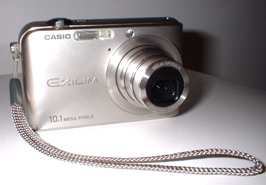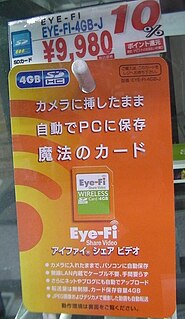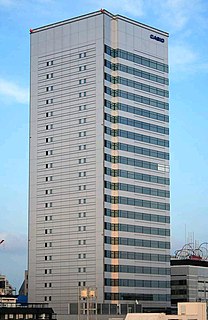
Windows Millennium Edition, or Windows Me, is a graphical operating system developed by Microsoft as part of its Windows 9x family of operating systems. It is the successor to Windows 98, and was released to manufacturing on June 19, 2000, with general availability on September 14, 2000.

In computer science, a library is a collection of non-volatile resources used by computer programs, often for software development. These may include configuration data, documentation, help data, message templates, pre-written code and subroutines, classes, values or type specifications. In IBM's OS/360 and its successors they are referred to as partitioned data sets.
Exchangeable image file format is a standard that specifies the formats for images, sound, and ancillary tags used by digital cameras, scanners and other systems handling image and sound files recorded by digital cameras. The specification uses the following existing file formats with the addition of specific metadata tags: JPEG discrete cosine transform (DCT) for compressed image files, TIFF Rev. 6.0 for uncompressed image files, and RIFF WAV for audio files. It is not used in JPEG 2000 or GIF.
Picture Transfer Protocol (PTP) is a protocol developed by the International Imaging Industry Association to allow the transfer of images from digital cameras to computers and other peripheral devices without the need of additional device drivers. The protocol has been standardized as ISO 15740.
Relocation is the process of assigning load addresses for position-dependent code and data of a program and adjusting the code and data to reflect the assigned addresses. Prior to the advent of multiprocess systems, and still in many embedded systems the addresses for objects were absolute starting at a known location, often zero. Since multiprocessing systems dynamically link and switch between programs it became necessary to be able to relocate objects using position-independent code. A linker usually performs relocation in conjunction with symbol resolution, the process of searching files and libraries to replace symbolic references or names of libraries with actual usable addresses in memory before running a program.

Exilim is a brand of digital cameras introduced in 2002 by Casio.
Digital "darkroom" is the hardware, software and techniques used in digital photography that replace the darkroom equivalents, such as enlarging, cropping, dodging and burning, as well as processes that don't have a film equivalent.
A camera raw image file contains minimally processed data from the image sensor of either a digital camera, a motion picture film scanner, or other image scanner. Raw files are named so because they are not yet processed and therefore are not ready to be printed or edited with a bitmap graphics editor. Normally, the image is processed by a raw converter in a wide-gamut internal color space where precise adjustments can be made before conversion to a "positive" file format such as TIFF or JPEG for storage, printing, or further manipulation. This often encodes the image in a device-dependent color space. There are dozens, if not hundreds, of raw formats in use by different models of digital equipment.
In computing, a dynamic linker is the part of an operating system that loads and links the shared libraries needed by an executable when it is executed, by copying the content of libraries from persistent storage to RAM, and filling jump tables and relocating pointers. The specific operating system and executable format determine how the dynamic linker functions and how it is implemented.

Digital photography uses cameras containing arrays of electronic photodetectors to capture images focused by a lens, as opposed to an exposure on photographic film. The captured images are digitized and stored as a computer file ready for further digital processing, viewing, digital publishing or printing.
The Windows NT startup process is the process by which Windows NT 4.0, Windows 2000, Windows XP and Windows Server 2003 operating systems initialize. In Windows Vista and later, this process has changed significantly; see Windows Vista startup process for information about what has changed.

Windows Photo Gallery is an image organizer, photo editor and photo sharing app. It is a part of Microsoft's Windows Essentials software suite. Microsoft announced that the product would no longer be supported or be available for download after January 10, 2017.
Windows Image Acquisition is a proprietary Microsoft driver model and application programming interface (API) for Microsoft Windows ME and later Windows operating systems that enables graphics software to communicate with imaging hardware such as scanners, digital cameras, and digital video equipment. It was first introduced in 2000 as part of Windows ME, and continues to be the standard imaging device and API model through successive Windows versions. It is implemented as an on-demand service in Windows XP and later Windows operating systems.
Linux color management has the same goal as the color management systems (CMS) for other operating systems: to achieve the best possible color reproduction throughout an imaging workflow from its source, through imaging software, and finally onto an output medium. In particular, color management attempts to enable color consistency across media and throughout a color-managed workflow.
Windows Imaging Component (WIC) is a Component Object Model based imaging codec framework introduced in Windows Vista for working with and processing digital images and image metadata. It allows applications supporting the framework to automatically get support of installed codecs for graphics file formats.

Eye-Fi was a company based in Mountain View, California that produced SD memory cards and SDHC cards with Wi-Fi capabilities. Using an Eye-Fi card inside a digital camera, one could wirelessly and automatically upload digital photos to a local computer or a mobile device such as a smartphone or tablet.

The Apple QuickTake is one of the first consumer digital camera lines. It was launched in 1994 by Apple Computer and was marketed for three years before being discontinued in 1997. Three models of the product were built including the 100 and 150, both built by Kodak; and the 200, built by Fujifilm. The QuickTake cameras had a resolution of 640 x 480 pixels maximum. The 200 model is only officially compatible with the Apple Macintosh for direct connections, while the 100 and 150 model are compatible with both the Apple Macintosh and Microsoft Windows. Because the QuickTake 200 is almost identical to the Fuji DS-7 or to Samsung's Kenox SSC-350N, Fuji's software for that camera can be used to gain Windows compatibility for the QuickTake 200. Some other software replacements also exist as well as using an external reader for the removable media of the QuickTake 200.

Windows Camera is an image and video capture utility included with the most recent versions of Windows and its mobile counterpart. It has been around on Windows-based mobile devices since camera hardware was included on those devices and was introduced on Windows PCs with Windows 8, providing users for the first time a first-party built-in camera that could interact with webcam hardware. It is similar in structure and features to the eponymous iOS and Android apps.












